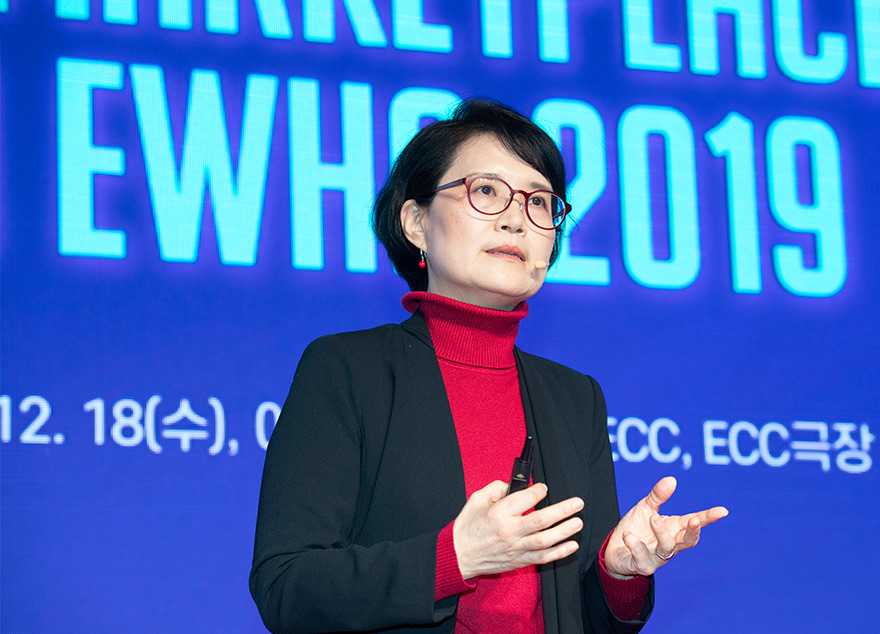
Does exposure to PM10 decrease age at menarche
Eun Hee Ha (eunheeha@ewha.ac.kr)
College of Medicine
Average age at menarche had declined from 14.2 years old in 1970 to 12.7 years old in 2010 in South Korea. A potential risk factor for early menarche is exposure to particulate matter (PM). Particulate matter (PM) is one of the environmental stressors, composed of diverse components, including EDCs, heavy metals, and polycyclic aromatic hydrocarbons (PAHs). Some of components of PM can interfere with estrogen receptor signaling pathway through estrogen mimicry (Georgescu et al., 2011; Santodonato, 1997; Sievers et al., 2013), resulting in disturbed biosynthesis of hormones and altered hormone levels. After accumulating various compounds from anthropogenic sources, PM may exhibit endocrine disrupting properties, which account for the decrease in age at menarche. Therefore, the objective of our study was to examine the association between pre-menarcheal exposure to PM≤10 μm in diameter(PM10) and age at menarche in adolescents of South Korea using Korea National Health and Nutrition Examination Survey (KNHANES) 2010–2012 data.
We used self-reported age at menarche of 639 girls aged 13–17 years in this study. The cut-off age for early menarche was set to 12 years. Based on each subject's address, 1-year, 2-year, and 3-year averages of annual mean PM10 concentrations (models1–3) were linked to KNHANES. Models were adjusted for body mass index (BMI), city size, household income level, maternal age at menarche, and second-hand smoke exposure at home. SURVEYREG and SURVEYLOGISTIC procedures were used to address the complex survey design of KNHANES.
Figure 1. Schematic representation of exposure periods
Overall analysis showed that exposure to PM10 has a significant effect on decreasing age at menarche. Multiple linear regression results suggested that each 1μg/m3 increase in 1-year, 2-year, 3-year averages of annual mean PM10 concentrations accelerated age at menarche by 0.046 years(95%CI:−0.064,−0.027;p<.0001), 0.038years(95%CI:−0.059,−0.018;p=0.0003), and 0.031 years(95%CI:−0.047,−0.015;p=0.0002), respectively. Adjusted ORs for a 1μg/m3 increase in PM10 concentration were 1.08(95% CI:1.04−1.12) for model 1, 1.06(95% CI:1.02−1.10) for model 2, and 1.05(95% CI:1.01−1.09) for model 3.
Firure 2. Graphical presentation of unadjusted and adjusted ORs (95% CIs) of early menarche for an increase of 1μg/m3 in PM10 concentration in models 1–3, KNHANES, 2010–2012.
Our findings suggest that elevated PM10 concentration can decrease age at menarche. In addition, our findings also revealed that PM might play a role in disrupting the endocrine system, adding evidence to the previous literature. Prospective cohort studies need to be conducted to corroborate the association between PM exposure and the decrease in age at menarche.
* Related Article
Damstra, T., 2002. Global Assessment of the State-of-the-science of Endocrine Disruptors: An Assessment Prepared by an Expert Group on Behalf of the World Health Organization, the International Labour Organisation, and the United Nations Environment Programme. World Health Organization
Levy, J.I., Dumyahn, T., Spengler, J.D., 2002, Particulate matter and polycyclic aromatic hydrocarbon concentrations in indoor and outdoor microenvironments in Boston, Massachusetts, J. Expo. Anal. Environ. Epidemiol, 12, 104-114.
Lim, J.-M., Lee, J.-H., Moon, J.-H., Chung, Y.-S., Kim, K.-H., 2010, Airborne PM10 and metals from multifarious sources in an industrial complex area, Atmos. Res. 96, 53-64.
Georgescu, B., Georgescu, C., Dărăban, S., Bouaru, A., Paşcalău, S., 2011, Heavy metals acting as endocrine disrupters, Scientific Papers Animal Science and Biotechnologies, 44, 89-93.
Santodonato, J., 1997, Review of the estrogenic and antiestrogenic activity of polycyclic aromatic hydrocarbons: relationship to carcinogenicity, Chemosphere 34, 835-848.
Sievers, C.K., Shanle, E.K., Bradfield, C.A., Xu, W., 2013, Differential action of monohydroxylated polycyclic aromatic hydrocarbons with estrogen receptors α and β., Toxicol. Sci. 132, 359-367.
Jung, E.M., Kim, H.S., Park, H., Ye, S., Lee, D. and Ha, E.H., 2018, Does exposure to PM 10 decrease age at menarche?, Environment international, 117, 16-21

